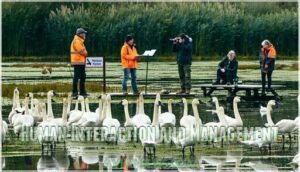This site is supported by our readers. We may earn a commission, at no cost to you, if you purchase through links.
 Every winter, roughly 100,000 tundra swans descend on the marshes and agricultural fields of North America, completing one of the continent’s most impressive migrations. These elegant waterfowl, with their pure white plumage and distinctive whistling calls, travel thousands of miles between Arctic breeding grounds and temperate wintering areas, finding their way by instinct and experience.
Every winter, roughly 100,000 tundra swans descend on the marshes and agricultural fields of North America, completing one of the continent’s most impressive migrations. These elegant waterfowl, with their pure white plumage and distinctive whistling calls, travel thousands of miles between Arctic breeding grounds and temperate wintering areas, finding their way by instinct and experience.
You might spot them in large flocks feeding on waste grain or resting in shallow wetlands, their long necks curved gracefully as they forage.
Though they’re classified as "Least Concern," tundra swans face mounting pressures from habitat loss, climate change, and lead poisoning that threaten their ancient migration routes and breeding success.
Table Of Contents
- Key Takeaways
- Tundra Swan Classification and Identification
- Natural Habitat and Geographic Range
- Behavior, Diet, and Life Cycle
- Population Status and Conservation
- Human Interaction and Management
- Frequently Asked Questions (FAQs)
- How rare are Tundra Swans?
- What’s the difference between a Trumpeter Swan and a tundra swan?
- What is a tundra swan called?
- How many Tundra Swans are left?
- What do tundra swans eat during migration?
- How long do tundra swans live in the wild?
- Do tundra swans mate for life?
- What predators threaten tundra swan populations?
- How do tundra swans communicate with each other?
- What sound do Tundra Swans make in flight?
- Conclusion
Key Takeaways
- Tundra swans migrate thousands of miles each year between Arctic breeding grounds and temperate wintering areas, adapting to both wild wetlands and agricultural fields.
- Their population remains stable at around 280,000 globally, but habitat loss, climate change, and lead poisoning present ongoing threats.
- Identification is easiest by their pure white plumage, black legs, and a yellow spot at the bill’s base, while juveniles are brownish-gray and lack the yellow mark.
- Conservation relies on regulated hunting, wetland restoration, invasive species management, and community involvement to ensure their continued survival.
Tundra Swan Classification and Identification
When you spot a swan in the wild, knowing what you’re looking at starts with understanding the basics. The tundra swan belongs to a specific scientific group and has features that set it apart from its close relatives.
Let’s break down how to recognize these birds, from their official classification to the telltale marks that distinguish young swans from adults.
Scientific Classification and Common Names
If you’ve ever watched a flock of pure white birds descend from winter skies with wings that seem to whistle, you’ve likely encountered the tundra swan—scientifically known as Cygnus columbianus, a member of the Anseriformes order and Anatidae family. You’ll also hear these elegant birds called "whistling swans" in English-speaking regions, while Spanish speakers know them as Cisne Chico and French Canadians call them Cygne siffleur. Within the genus Cygnus, species columbianus stands distinct, though taxonomic debate occasionally surfaces about subspecies distinctions across their range.
Common names for tundra swans include:
- Whistling swans (traditional North American name)
- Cisne Chico (Spanish designation)
- Cygne siffleur (French Canadian term)
- Bewick’s swan (Eurasian subspecies reference)
Physical Characteristics and Size Comparison
When you spot a tundra swan up close, you’ll immediately notice the striking contrast between its pure white plumage and jet-black bill, which usually features a small yellow spot at the base—though not all individuals display this mark. Their heavy bodies and long necks give them an elegant, straight-necked posture.
You’ll find they’re larger than a Snow Goose but smaller than Mute or Trumpeter Swans, with black legs and feet. Juveniles display brownish-gray plumage coloration before maturing into adults’ spotless white feathers, and their wingspan measurements reveal substantial size variations across populations.
Differences From Other Swan Species
Telling tundra swans apart from their relatives comes down to a few key traits. Size comparison places them between trumpeter swans (larger) and Bewick’s swans (smaller), with a slightly different neck posture and bill coloration that distinguish them from mute swans. North Carolina is an important wintering ground for these birds.
Here’s what sets them apart:
- Bill coloration: Trumpeter swans have all-black bills, while tundra swans show a yellow spot at the base
- Vocalizations: Tundra swans produce soft whistling calls, unlike trumpeters’ deeper, horn-like sounds
- Temperament: They’re less aggressive than mute swans, which display territorial behavior year-round
- Swan subspecies comparison: Bewick’s swans feature more extensive yellow on their bills than North American tundra swan populations
Identifying Juveniles Vs. Adults
Once you know what makes tundra swans different from other species, you’ll notice that age brings its own set of visual changes worth watching for.
Adults display pure white plumage with distinct black bill markings and a yellow spot at the base, while juveniles appear brownish gray overall. Their bills lack the characteristic yellow marking, making age determination straightforward when you’re observing flocks during migration or at wintering sites.
Natural Habitat and Geographic Range
Tundra swans don’t stick to one place—they’re true nomads, traveling thousands of miles between breeding, migration, and wintering grounds. Their range stretches from the remote Arctic tundra to coastal marshes and agricultural fields across North America.
Tundra swans are true nomads, journeying thousands of miles each year between their Arctic breeding grounds and North American wetlands
Let’s look at where you’ll find these elegant birds throughout the year.
Arctic Breeding Grounds
Tundra swans return each spring to the remote subarctic and arctic tundra, where vast, treeless landscapes offer the isolation and shallow wetlands essential for nesting and rearing their young.
You’ll find these breeding birds selecting nesting territory near ponds and lakes, where arctic food sources like sedges and aquatic plants support breeding success.
Climate impacts and habitat loss increasingly challenge their breeding grounds, while predator interactions with foxes and gulls test their nesting ecology throughout the season.
Migration Routes Across North America
Each fall, you’ll witness tundra swans following migration corridors west of the Rocky Mountains and across North Dakota, guided by route fidelity and navigation strategies honed over generations.
These bird migration patterns reflect striking stopover ecology, as flocks rest at wetlands along the way. Climate impacts increasingly shift timing and routes, yet tundra swan migration patterns remain one of North America’s most reliable wildlife spectacles.
During migration, they may stop at locations like Goose Pond Sanctuary.
Wintering Locations and Key Habitats
By December, you’ll find tundra swans concentrated at coastal marshes and interior wetlands where shallow waters and agricultural fields meet their winter foraging needs. The delta marshes of San Francisco Bay and Chesapeake Bay serve as critical wintering grounds, where estuaries and coastal waters provide abundant submerged vegetation.
You’ll also spot flocks in agricultural fields feeding on waste grains, though habitat loss increasingly pressures these traditional wetlands.
Adaptation to Agricultural Environments
When farm fields replace wetlands, tundra swans don’t abandon ship—they adapt, trading their traditional diet of aquatic plants for the buffet of waste grains left behind after harvest. These foraging strategies reflect striking flexibility, as agricultural fields now complement traditional wintering grounds.
During spring migration, their crop consumption includes:
- Corn (31.38% of diet)
- Quinoa (18.21%)
- Rice (16.68%)
- Millet (13.49%)
- Winter cereals from cultivated fields
This habitat modification benefits both swans and farmers, as the birds clean up waste grain while finding abundant food sources during critical feeding periods.
Behavior, Diet, and Life Cycle
Tundra swans live complex lives shaped by the seasons and their surroundings. Their behaviors, from migration to feeding and nesting, reflect adaptations to harsh arctic conditions and changing food sources.
Here’s what you need to know about how these birds survive and thrive throughout the year.
Flocking and Social Behavior
You’ll find tundra swans are remarkably social birds, gathering in flocks that can range from small family groups to congregations numbering in the hundreds or even thousands during migration and winter.
Their flock behavior includes cooperative foraging, where they work together to access food sources, and complex flock communication through vocalizations and body language.
Social hierarchy within these groups influences mate selection and guarantees coordinated predator avoidance, making swan behavior a fascinating example of survival through community.
Seasonal Migration Patterns
Each spring and fall, these white-winged travelers begin one of North America’s most impressive journeys, covering thousands of miles between their Arctic breeding grounds and temperate wintering areas. Migration triggers include changing daylight hours and declining food availability, prompting these migratory birds to follow established route variations west of the Rocky Mountains and across North Dakota.
Stopover ecology plays an important role, as tundra swans rest at wetlands to refuel before continuing their journey to wintering grounds like San Francisco Bay and Chesapeake Bay, where climate impacts increasingly influence their arrival timing and navigation methods.
Primary Diet and Foraging Habits
After refueling at migration stopovers, tundra swans need to rebuild their energy reserves quickly, and that’s where their specialized diet comes into play—over 95% of what they eat consists of aquatic plants, including tubers, roots, stems, and leaves pulled from shallow wetlands and marshes. During winter, you’ll find them adapting their foraging behavior to agricultural fields, where they consume waste grains like corn, rice, and millet. This seasonal diet shift showcases striking diet adaptations that help these birds thrive across diverse habitats.
5 Key Facts About Tundra Swan Feeding Habits:
- They submerge their long necks underwater to reach aquatic vegetation in shallow lakes and estuaries
- Agricultural foraging supplements their natural plant consumption during harsh winter months
- Spring migrants consume up to 31% corn by relative particle density at key stopover sites
- Their heavy bodies require constant energy intake to sustain long-distance flights
- Wetlands provide critical feeding grounds where they extract nutrient-rich tubers and roots
Breeding and Nesting Habits
Once tundra swans have fueled up for their journeys, their next priority shifts to the demanding work of raising their offspring on the remote breeding grounds of the Arctic tundra. During the breeding season, pairs select nest sites near shallow ponds or lake edges, where they build substantial mounds using moss, grass, and lichens. Females usually lay 3 to 5 eggs per clutch, with both parents sharing incubation duties for approximately 30 to 32 days—a critical period when predators pose significant threats.
| Breeding Stage | Details |
|---|---|
| Nest site selection & building | Shallow tundra ponds; mound nests from vegetation |
| Egg laying & clutch size | 3–5 creamy-white eggs per season |
| Incubation period | 30–32 days, shared parental care |
| Fledgling survival | Young cygnets remain with parents through first migration |
After hatching, parental care becomes intensive as adults guide their brownish-gray cygnets through the brief Arctic summer, teaching them essential foraging skills that determine fledgling survival rates before the family’s southward migration begins.
Population Status and Conservation
Understanding tundra swan numbers helps you see how well these birds are doing across their range. Scientists track populations carefully to spot trends and potential problems.
Here’s what the data tells us about their current status and what’s being done to protect them.
Global and Regional Population Estimates
Globally, you’re looking at roughly 280,000 tundra swans as of 2025, with North America hosting the majority—between 170,000 and 190,000 birds. Regional variations are striking: the Western Population averages 90,000–100,000 individuals, while the Eastern Population hovers around 103,400.
Survey methods like mid-winter counts and productivity surveys track annual fluctuations, revealing survival rates of 92% for adults and conservation benchmarks that keep populations stable. Annual harvest estimates run 2,300–2,800 birds, manageable given current numbers.
Population Trends and Monitoring Methods
Tracking tundra swan numbers relies on systematic approaches like the MidWinter Waterfowl Inventory and productivity surveys, which reveal annual fluctuations and inform conservation efforts. Data analysis shows populations have remained stable to increasing since 2000, with future projections suggesting continued resilience.
Survey techniques capture:
- Mid-winter counts across wintering grounds to estimate population size
- Productivity surveys measuring breeding success and juvenile ratios
- Annual fluctuations tracking survival rates and harvest impacts
- Population monitoring through standardized protocols ensuring long-term trend accuracy
Conservation Status and Threats
Despite its "Least Concern" classification by IUCN, tundra swans face real pressures from habitat loss, climate impacts, and hunting effects. Wetland drainage, agricultural expansion, and projected 4–5°C temperature increases threaten breeding grounds, while lead poisoning from spent ammunition kills wintering birds at alarming rates. Conservation efforts include regulated hunting permits (6,000–7,000 annually), wetland restoration projects, and lead shot phase-outs across key habitats.
| Threat Category | Primary Causes | Conservation Response |
|---|---|---|
| Habitat degradation | Wetland drainage, oil exploration, pollution | Protected refuges, restoration initiatives |
| Direct mortality | Legal harvest (2,300–2,800), lead poisoning | Permit limits, non-toxic ammunition programs |
| Climate change | Arctic warming, vegetation loss | Adaptation research, monitoring protocols |
Impact of Non-native Species
When non-native mute swans and reed canarygrass invade tundra swan territories, you’re watching a competition for space and food that reshapes entire ecosystems. Habitat competition forces native birds from prime wetlands, while disease transmission threatens vulnerable populations.
Ecosystem disruption from nonnative species impacts foraging areas and breeding success. Management strategies now target invasive vegetation removal and mute swan control to protect tundra swan ecology and support swan conservation efforts.
Human Interaction and Management
Tundra swans share their habitats with people in ways that require careful balance. Hunting, monitoring, and habitat management all play a role in keeping populations healthy while allowing people to connect with these birds.
Here’s how different groups work together to manage and protect tundra swans across North America.
Hunting Regulations and Permit Allocation
You might be surprised to learn that tundra swan hunting is carefully regulated through a lottery-based permit system that balances conservation with recreational opportunities. Each year, wildlife agencies allocate permits through a permit lottery to control hunter harvest, particularly for the Eastern Population of Tundra Swans, while enforcement challenges persist in distinguishing legal targets from protected species.
Key Swan Hunting Regulations include:
- Bag limits restrict the number of birds you can take per season, usually one or two swans depending on your hunting zone
- Legal ammunition requirements mandate non-toxic shot to prevent lead poisoning in wetland ecosystems
- Hunting zones are designated based on migration corridors and wintering grounds, sustainable harvest across different populations
Waterfowl Management Strategies
Managing waterfowl populations requires a delicate balance between protecting migration corridors, preserving wetland ecosystems, and accommodating human activities across diverse landscapes. Effective wildlife management integrates habitat preservation with hunting quotas to maintain healthy population levels.
Wetland restoration projects offset agricultural impacts, while population monitoring tracks conservation status across seasons. These coordinated waterfowl management efforts help tundra swans and other species thrive despite competing land uses.
Research and Monitoring Projects
Scientists have been tracking tundra swan populations since 1969, when neck-banding studies first began marking individuals for long-term survival analysis. Today, satellite tracking devices monitor over 70 swans across multiple breeding areas, revealing annual migration distances from 1,020 to 12,720 kilometers.
Health monitoring programs assess exposure to lead contaminants and avian influenza, while aerial surveys at key sites like Middle Creek Wildlife Management Area document annual fluctuations—one count reached 14,700 birds.
Data sharing through USGS and Movebank platforms facilitates wildlife research projects worldwide, helping you understand how habitat monitoring informs tundra swan population conservation strategies.
Community Involvement and Protection Efforts
Local communities have become the front-line defenders of tundra swan habitat, organizing volunteer monitoring events and advocating for wetland protection measures that directly impact migration success. Through Citizen Science initiatives and Educational Outreach programs, you can participate in conservation efforts that shape Policy Advocacy and Funding Allocation decisions:
- Habitat Restoration projects rebuild degraded wetlands critical for Waterfowl Management in North Carolina and other key wintering areas.
- Wildlife Research Projects track Conservation and Population Trends through coordinated observation networks.
- Community partnerships influence Hunting Permit Allocation policies that balance recreational use with Bird Reintroduction Programs.
Frequently Asked Questions (FAQs)
How rare are Tundra Swans?
With 280,000 individuals worldwide, these Arctic wanderers aren’t rare at all—they’re North America’s most widespread swan species.
Partners in Flight rates them at low conservation concern, and their numbers remain stable to increasing across the continent.
What’s the difference between a Trumpeter Swan and a tundra swan?
Trumpeter swans are the largest native waterfowl in North America, while tundra swans are slightly smaller with more compact bodies.
Bill coloration provides the clearest field mark: trumpeters display entirely black bills, whereas tundra swans show a distinctive yellow spot at the bill’s base.
What is a tundra swan called?
Across its range, this species goes by several names. Officially it’s the Tundra Swan, but you’ll also hear "whistling swan" due to its distinctive wing sounds.
In other languages, it’s known as Cisne Chico in Spanish and Cygne siffleur in French—both nods to its smaller size compared to other swans.
How many Tundra Swans are left?
As of 2025, the global breeding population stands at approximately 280,000 individuals, with North American populations stable to increasing.
Partners in Flight’s Continental Concern Score of 10 out of 20 indicates low conservation concern for these widespread waterfowl.
What do tundra swans eat during migration?
During migration, their diet shifts for maximum energy intake, aiding aquatic vegetation from wetlands with waste grains in agricultural fields.
This adaptability allows long flights and highlights their reliance on both natural habitats and agricultural foraging routes.
How long do tundra swans live in the wild?
Much like travelers along an uncertain road, wild swans often reach ages of 10 to 20 years.
Their wild longevity is shaped by lifespan factors such as habitat quality, migration challenges, and threats that influence average age and mortality.
Do tundra swans mate for life?
Long-term pair bonds are typical, but absolute mate fidelity isn’t guaranteed. Pair bond duration can span a lifetime, yet occasional divorce rates and rare extra-pair copulation occur.
Mate changes sometimes impact breeding success and the species’ life cycle.
What predators threaten tundra swan populations?
Stealthy foxes, eagles, and even gulls pose significant nest predation risks and highlight the cygnets’ vulnerability.
Avian predators and mammalian threats shift with habitat impact, showing how ecological study deepens our understanding of Tundra Swan behavior and range.
How do tundra swans communicate with each other?
Vocalizations and body language play a key role in family communication and pair bonding. Alarm calls help warn others of danger, while softer sounds, posture shifts, and synchronized gestures deepen bonds—classic traits in avian bird species identification and behavior.
What sound do Tundra Swans make in flight?
Like ice whistling in sunlight, the Wing Whistle Sound of these avian species blends with soft, high-pitched calls.
This acoustic adaptation aids Flight Communication, allowing their Vocalization Purpose and Sound Variation to maintain group cohesion, especially during migration.
Conclusion
When the spring thaw arrives, the tundra swan will take to the skies once more, reminding us that every migration tells a story of resilience and change.
By understanding their needs and the forces shaping their journey, you help keep wild connections alive—for these elegant birds but also for yourself.
The next time you hear their call overhead, remember: your actions can ripple outward, embracing both the swans and the world they traverse.











